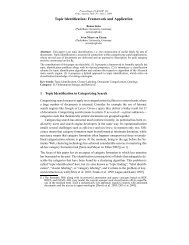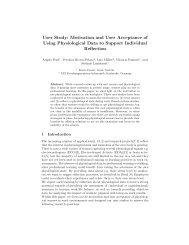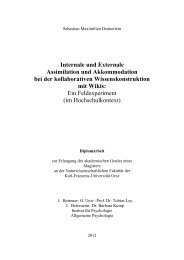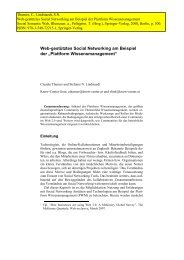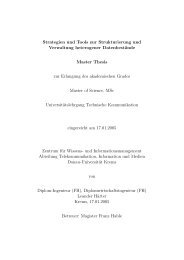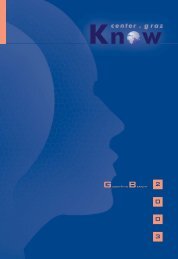Fostering adoption, acceptance and assimilation in ... - KnowMiner
Fostering adoption, acceptance and assimilation in ... - KnowMiner
Fostering adoption, acceptance and assimilation in ... - KnowMiner
You also want an ePaper? Increase the reach of your titles
YUMPU automatically turns print PDFs into web optimized ePapers that Google loves.
one of the models before. Therefore, there were no additional<br />
factors collected directly from the UTAUT model.<br />
2.3 Assimilation<br />
The follow<strong>in</strong>g models aim at expla<strong>in</strong><strong>in</strong>g the <strong>assimilation</strong> of a new<br />
technology by collectives of users <strong>in</strong>to their work processes <strong>and</strong><br />
practices.<br />
Institution Theory (INST) states that organizations’ <strong>and</strong><br />
<strong>in</strong>dividuals’ choices <strong>and</strong> behavior are <strong>in</strong>fluenced by social<br />
structures embedded <strong>in</strong> the environment. In this regard, three<br />
general differentiations compris<strong>in</strong>g regulative, normative, <strong>and</strong><br />
cognitive elements can be made. Regulative elements refer to the<br />
avoidance of violations aga<strong>in</strong>st laws <strong>and</strong> regulations by<br />
<strong>in</strong>dividuals to avoid organizational sanctions aga<strong>in</strong>st themselves.<br />
Normative elements are understood as embedd<strong>in</strong>g social<br />
underst<strong>and</strong><strong>in</strong>g <strong>in</strong>to decision-mak<strong>in</strong>g rules or procedures on an<br />
organizational level. Cognitive elements on an organizational<br />
level describe social structures that constitute the nature of reality<br />
<strong>and</strong> development of mean<strong>in</strong>g. Individual behavior <strong>in</strong> such cases is<br />
<strong>in</strong>formed by cognitive guidance that allow them underst<strong>and</strong><strong>in</strong>g<br />
how they should behave [3,26].<br />
Structuration Theory (ST) is a frequently used theory <strong>in</strong> IS<br />
research [27] <strong>and</strong> is the basis for Adaptive Structuration Theory<br />
(AST). These theories are appeal<strong>in</strong>g to IS research, s<strong>in</strong>ce they<br />
focus on social aspects of IS, <strong>in</strong> particular they analyze structure<br />
<strong>and</strong> the processes by which structures are used <strong>and</strong> modified over<br />
time [28]. The theories comprise a number of concepts that help to<br />
underst<strong>and</strong> how users <strong>in</strong>terpret IS <strong>and</strong> how they actually use them<br />
compared to the <strong>in</strong>tended usage by designers <strong>and</strong> developers,<br />
called appropriation. This is an <strong>in</strong>herently social process relat<strong>in</strong>g<br />
to the collective behavior of the group of users <strong>and</strong> stakeholders<br />
affected by a new system. It expla<strong>in</strong>s how organizational<br />
structures <strong>and</strong> rout<strong>in</strong>es are impacted by the use of IS on the one<br />
h<strong>and</strong> <strong>and</strong> how IS are <strong>in</strong>terpreted from the perspective of the<br />
organizational structures <strong>and</strong> rout<strong>in</strong>es on the other h<strong>and</strong> [29].<br />
An <strong>in</strong>terpretation of the DOI theory emphasizes the role of<br />
knowledge <strong>and</strong> organizational learn<strong>in</strong>g as potential barriers to<br />
successful rollout of <strong>in</strong>novations <strong>and</strong> provides a<br />
reconceptualization of the diffusion theory for complex<br />
organizational technologies [30]. These complex technologies<br />
create a knowledge barrier to the users that <strong>in</strong>hibits diffusion.<br />
Therefore, technology suppliers should actively encourage<br />
diffusion by develop<strong>in</strong>g procedures that lower knowledge barriers<br />
<strong>in</strong> order to improve the <strong>assimilation</strong> [31]. Hence, DOI is also<br />
useful for expla<strong>in</strong><strong>in</strong>g <strong>assimilation</strong> of IT <strong>in</strong>to processes <strong>and</strong><br />
practices, e.g., it was applied to exam<strong>in</strong>e the <strong>assimilation</strong> of<br />
collaborative <strong>in</strong>formation technologies [32].<br />
The Knowledge-based Theory of the firm (KBT) considers<br />
knowledge as a resource that has strategic significance for<br />
organizations. Potential competitive advantage <strong>and</strong> susta<strong>in</strong>ability<br />
can be achieved due to the fact that knowledge compris<strong>in</strong>g<br />
policies, rout<strong>in</strong>es, or employees is difficult to imitate <strong>and</strong> socially<br />
complex <strong>in</strong> the sense that it is embedded <strong>in</strong> the social fabric of<br />
collectives of people which cannot easily be transferred [33, 34].<br />
Besides the models <strong>and</strong> theories above, we looked <strong>in</strong>to<br />
characteristics of (bus<strong>in</strong>ess) processes <strong>in</strong> order to help decision<br />
makers judge whether changes consider<strong>in</strong>g work processes <strong>and</strong><br />
practices have improved organizational performance. Bus<strong>in</strong>ess<br />
process management (BPM) [35] has also been extended to cover<br />
processes of knowledge work [36]. As <strong>assimilation</strong> refers to the<br />
actual use of the adopted technology with<strong>in</strong> processes, it seems<br />
useful to consider the follow<strong>in</strong>g factors that correspond to<br />
qualitative <strong>and</strong> quantitative process goals: process quality<br />
(qualitative <strong>and</strong> quantitative process goals), process costs<br />
(quantitative process goals), <strong>and</strong> process time (temporal process<br />
goals) <strong>and</strong> customer process satisfaction (process-external view of<br />
quality) [37,38].<br />
3. METHOD<br />
The models presented above give valuable <strong>in</strong>sights <strong>in</strong>to <strong>adoption</strong>,<br />
<strong>acceptance</strong> or <strong>assimilation</strong> from different po<strong>in</strong>ts of view with<br />
different focuses <strong>and</strong> partly overlapp<strong>in</strong>g concepts. However, <strong>in</strong><br />
order to consider <strong>and</strong> improve these topics with<strong>in</strong> the design of a<br />
KMS, a more comprehensive <strong>and</strong> consolidated model is needed<br />
that gives an overview of factors <strong>in</strong>fluenc<strong>in</strong>g the <strong>adoption</strong>,<br />
<strong>acceptance</strong> <strong>and</strong> <strong>assimilation</strong> of KMS, thus reduc<strong>in</strong>g complexity<br />
<strong>and</strong> present<strong>in</strong>g the models <strong>and</strong> theories <strong>in</strong> a form that is more<br />
easily underst<strong>and</strong>able <strong>and</strong> applicable for decision makers<br />
responsible for design, development <strong>and</strong> implementation of KMS.<br />
Additionally, it would be helpful to dist<strong>in</strong>guish between factors<br />
that can be <strong>in</strong>fluenced by KMS design <strong>and</strong> factors that cannot.<br />
Therefore, we comb<strong>in</strong>ed the models <strong>and</strong> theories named above<br />
expla<strong>in</strong><strong>in</strong>g behavior of <strong>in</strong>dividuals <strong>and</strong> organizations us<strong>in</strong>g IT<br />
with the aim to use the result<strong>in</strong>g model as guidance for KMS<br />
design purposes. For each of the three topics, i.e. <strong>adoption</strong>,<br />
<strong>acceptance</strong> <strong>and</strong> <strong>assimilation</strong>, we collected highly cited models<br />
which we analyzed sequentially, extract<strong>in</strong>g <strong>in</strong>fluenc<strong>in</strong>g factors<br />
given <strong>in</strong> the model or theory. In do<strong>in</strong>g so, we got three sets of<br />
factors that <strong>in</strong>fluence <strong>adoption</strong>, <strong>acceptance</strong> or <strong>assimilation</strong><br />
respectively <strong>and</strong> orig<strong>in</strong>ate <strong>in</strong> one or more of the models <strong>and</strong><br />
theories discussed <strong>in</strong> Section 2. In order to improve<br />
underst<strong>and</strong>ability <strong>and</strong> reusability of the 81 collected factors, we<br />
further categorized them thematically <strong>in</strong>to 17 factor groups. Thus,<br />
we provide a structured basis for subsequent work with our<br />
comprehensive model. The factors are listed <strong>in</strong> tables <strong>in</strong> the<br />
follow<strong>in</strong>g three subsections. A def<strong>in</strong>ition of the s<strong>in</strong>gle factors can<br />
be found <strong>in</strong> the literature given for the respective model or theory.<br />
The factors need to be operationalized accord<strong>in</strong>g to the specific<br />
context of a situation of an organization will<strong>in</strong>g to adopt a KMS,<br />
e.g., characteristics of the bus<strong>in</strong>ess sector to be addressed by the<br />
KMS. An example for the <strong>in</strong>terpretation of factors with<strong>in</strong> a special<br />
context is given as part of Section 4.<br />
In a last step, we analyzed the factor groups <strong>in</strong> respect to whether<br />
they can be <strong>in</strong>fluenced with<strong>in</strong> the design or not, i.e. if the factors<br />
with<strong>in</strong> one group can be <strong>in</strong>fluenced by design decisions. In the<br />
follow<strong>in</strong>g, these steps are presented <strong>in</strong> more detail <strong>in</strong> the<br />
respective subsections.<br />
3.1 Adoption Factors<br />
We collected 37 factors <strong>in</strong>fluenc<strong>in</strong>g the organizations’ decision on<br />
adopt<strong>in</strong>g a KMS which are presented together with their<br />
orig<strong>in</strong>at<strong>in</strong>g model or theory <strong>in</strong> table 1.<br />
Furthermore, we categorized the factors <strong>in</strong>fluenc<strong>in</strong>g the <strong>adoption</strong><br />
<strong>in</strong>to eight groups depend<strong>in</strong>g on the thematic orig<strong>in</strong> of the factors.<br />
The Environment group comb<strong>in</strong>es factors external to the adopt<strong>in</strong>g<br />
organization; the Innovation Characteristics groups collects<br />
factors that are def<strong>in</strong>ed only by the KMS product itself <strong>and</strong> the<br />
type of <strong>in</strong>novation it represents; Fit comb<strong>in</strong>es factors related to the<br />
suitability of the KMS solution to the tasks it is <strong>in</strong>tended to<br />
support <strong>and</strong> the <strong>in</strong>frastructure it is <strong>in</strong>tended to be applied <strong>in</strong><br />
<strong>in</strong>fluenced by the solution itself as well as the organization;<br />
Expected Results comb<strong>in</strong>es factors related to the perceived quality<br />
<strong>and</strong> impact of the KMS’s <strong>adoption</strong>; the factors with<strong>in</strong> the group<br />
Organizational Characteristics correspond to general properties<br />
of the adopt<strong>in</strong>g organization, while the groups Communication




